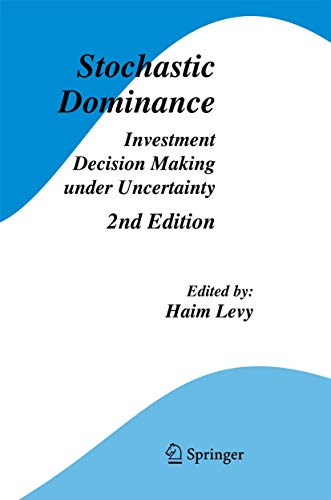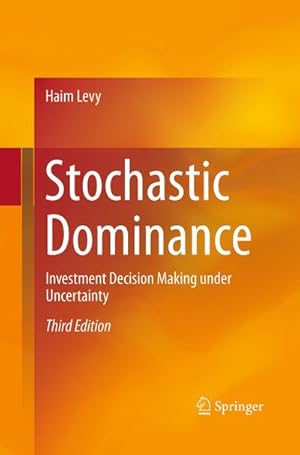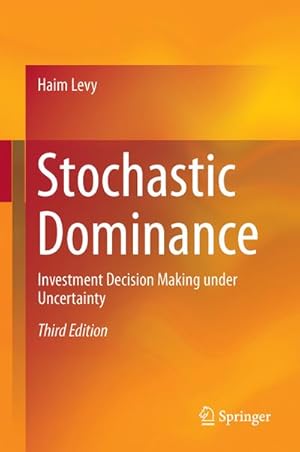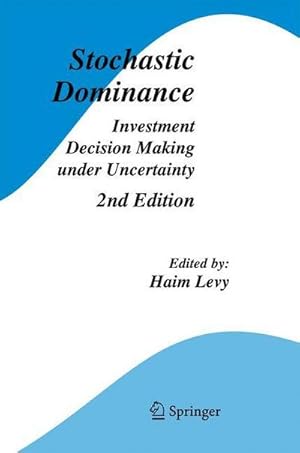stochastic dominance investment decision von levy haim (4 Ergebnisse)
Produktart
- Alle Produktarten
- Bücher (4)
- Magazine & Zeitschriften
- Comics
- Noten
- Kunst, Grafik & Poster
- Fotografien
- Karten
-
Manuskripte &
Papierantiquitäten
Zustand
Einband
Weitere Eigenschaften
- Erstausgabe
- Signiert
- Schutzumschlag
- Angebotsfoto (3)
Gratisversand
Land des Verkäufers
Verkäuferbewertung
-
Stochastic Dominance: Investment Decision Making Under Uncertainty
Verlag: SPRINGER VERLAG GMBH, 2006
ISBN 10: 0387293027ISBN 13: 9780387293028
Anbieter: Buchpark, Trebbin, Deutschland
Buch
Zustand: Sehr gut. Zustand: Sehr gut - Neubindung, Buchschnitt leicht verkürzt, Buchrücken leicht angestoßen, Ausg. 2006 | Seiten: 439 | Sprache: Englisch.
-
Stochastic Dominance : Investment Decision Making under Uncertainty
Verlag: Springer International Publishing, 2016
ISBN 10: 3319330594ISBN 13: 9783319330594
Anbieter: AHA-BUCH GmbH, Einbeck, Deutschland
Buch
Taschenbuch. Zustand: Neu. Druck auf Anfrage Neuware - Printed after ordering - This fully updated third edition is devoted to the analysis of various Stochastic Dominance (SD) decision rules. It discusses the pros and cons of each of the alternate SD rules, the application of these rules to various research areas like statistics, agriculture, medicine, measuring income inequality and the poverty level in various countries, and of course, to investment decision-making under uncertainty. The book features changes and additions to the various chapters, and also includes two completely new chapters. One deals with asymptotic SD and the relation between FSD and the maximum geometric mean (MGM) rule (or the maximum growth portfolio). The other new chapter discusses bivariate SD rules where the individual's utility is determined not only by his own wealth, but also by his standing relative to his peer group. Stochastic Dominance: Investment Decision Making under Uncertainty, 3rd Ed. covers the following basic issues: the SD approach, asymptotic SD rules, the mean-variance (MV) approach, as well as the non-expected utility approach. The non-expected utility approach focuses on Regret Theory (RT) and mainly on prospect theory (PT) and its modified version, cumulative prospect theory (CPT) which assumes S-shape preferences. In addition to these issues the book suggests a new stochastic dominance rule called the Markowitz stochastic dominance (MSD) rule corresponding to all reverse-S-shape preferences. It also discusses the concept of the multivariate expected utility and analyzed in more detail the bivariate expected utility case.From the reviews of the second edition:'This book is an economics book about stochastic dominance. . is certainly a valuable reference for graduate students interested in decision making under uncertainty. It investigates and compares different approaches and presents many examples. Moreover, empirical studies and experimental results play an important role in this book, whichmakes it interesting to read.' (Nicole Bäuerle, Mathematical Reviews, Issue 2007 d).
-
Stochastic Dominance : Investment Decision Making under Uncertainty
Verlag: Springer International Publishing, 2015
ISBN 10: 3319217070ISBN 13: 9783319217079
Anbieter: AHA-BUCH GmbH, Einbeck, Deutschland
Buch
Buch. Zustand: Neu. Druck auf Anfrage Neuware - Printed after ordering - This fully updated third edition is devoted to the analysis of various Stochastic Dominance (SD) decision rules. It discusses the pros and cons of each of the alternate SD rules, the application of these rules to various research areas like statistics, agriculture, medicine, measuring income inequality and the poverty level in various countries, and of course, to investment decision-making under uncertainty. The book features changes and additions to the various chapters, and also includes two completely new chapters. One deals with asymptotic SD and the relation between FSD and the maximum geometric mean (MGM) rule (or the maximum growth portfolio). The other new chapter discusses bivariate SD rules where the individual's utility is determined not only by his own wealth, but also by his standing relative to his peer group. Stochastic Dominance: Investment Decision Making under Uncertainty, 3rd Ed. covers the following basic issues: the SD approach, asymptotic SD rules, the mean-variance (MV) approach, as well as the non-expected utility approach. The non-expected utility approach focuses on Regret Theory (RT) and mainly on prospect theory (PT) and its modified version, cumulative prospect theory (CPT) which assumes S-shape preferences. In addition to these issues the book suggests a new stochastic dominance rule called the Markowitz stochastic dominance (MSD) rule corresponding to all reverse-S-shape preferences. It also discusses the concept of the multivariate expected utility and analyzed in more detail the bivariate expected utility case.From the reviews of the second edition:'This book is an economics book about stochastic dominance. . is certainly a valuable reference for graduate students interested in decision making under uncertainty. It investigates and compares different approaches and presents many examples. Moreover, empirical studies and experimental results play an important role in this book, whichmakes it interesting to read.' (Nicole Bäuerle, Mathematical Reviews, Issue 2007 d).
-
Stochastic Dominance : Investment Decision Making under Uncertainty
Verlag: Springer US, 2010
ISBN 10: 1441939830ISBN 13: 9781441939838
Anbieter: AHA-BUCH GmbH, Einbeck, Deutschland
Buch
Taschenbuch. Zustand: Neu. Druck auf Anfrage Neuware - Printed after ordering - This second edition of Stochastic Dominance is devoted to investment decision making under uncertainty. The book covers four basic approaches to this process: a) The stochastic dominance (SD) approach, developed on the foundation of von-Neumann and Morgenstem^ expected utiHty paradigm. b) The mean-variance approach developed by Markowitz^ on the foundation of von-Neumann and Morgenstern's expected utility or simply on the assumption of a utility function based on mean and variance. c) The 'almost' stochastic dominance (ASD) rules and the 'almost' me- variance rule (AMV). No matter whether one employs objective or subjective probabilities, the common stochastic dominance criteria and the mean variance rule may lead to paradoxes: they are unable to rank prospect A w^hich yields $1 with a probability of 0.01 and a million dollars with probability of 0.99, and prospect B which yields $2 with certainty. This is an absurdity as in any sample of subjects one takes, 100% of subjects choose A. The 'almost' stochastic dominance criteria and 'almost' mean variance rule, which have been recently been developed by Leshno and Levy in 2002^, suggest a remedy to such paradoxes.





